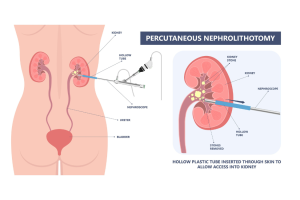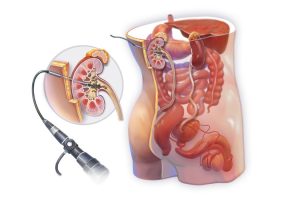Percutaneous Nephrolithotomy
 Kidney stones are some of the most common conditions that a urologist like Dr. Natale treats. Kidney stone formation tends to peak in the summer months due to dehydration caused by the heat, but patients can develop them year-round, too. There is undoubtedly a genetic component to kidney stone formation. Yet, most are caused by environmental and lifestyle factors, including the lack of water intake, eating certain foods, and other considerations. There are many different shapes and sizes of kidney stones, and they can be found within the kidneys themselves or within the ureters, the tubes that shuttle urine from the kidneys down to the bladder. These can all be treated in different ways, and you can learn more about extracorporeal shockwave lithotripsy or ESWL, and ureteroscopy on separate pages on our website. PCNL, on the other hand, is reserved for the most complex of kidney stone cases.
Kidney stones are some of the most common conditions that a urologist like Dr. Natale treats. Kidney stone formation tends to peak in the summer months due to dehydration caused by the heat, but patients can develop them year-round, too. There is undoubtedly a genetic component to kidney stone formation. Yet, most are caused by environmental and lifestyle factors, including the lack of water intake, eating certain foods, and other considerations. There are many different shapes and sizes of kidney stones, and they can be found within the kidneys themselves or within the ureters, the tubes that shuttle urine from the kidneys down to the bladder. These can all be treated in different ways, and you can learn more about extracorporeal shockwave lithotripsy or ESWL, and ureteroscopy on separate pages on our website. PCNL, on the other hand, is reserved for the most complex of kidney stone cases.
What makes a kidney stone complex?
By and large, kidney stones that reside in the ureters are not complex to remove because we can thread a scope up the urethra, through the bladder, and into the ureter, followed by deploying mechanical or laser energy to pulverize the stones. Smaller soft stones within the kidney are also relatively easy to attack using ESWL or shockwave therapy. However, stones within the kidney can become complex when they are hard to reach or very large. We routinely treat kidney stones up to 10 cm in size, which, for the sake of approximation, would suggest that there was more stone than kidney tissue within the affected kidney. The difficulty with these larger kidney stones is twofold.
- First, the sheer size of a kidney stone can compromise the kidney and ultimately lead to failure. The kidneys cannot function normally with a kidney stone of that size, and the result can be life-threatening if not treated early. For some, untreated kidney stones may require the removal of the kidney.
- Secondly, infections can form behind kidney stones due to the buildup of stagnant urine. This is problematic and difficult to treat because antibiotics cannot reach the infected area. These infections are considered an urgent concern, if not an emergency, and require immediate care.
To that end, the only entirely reliable treatment for complex stones within the kidney is surgical, in the form of PCNL.
How does PCNL work?
PCNL is the most invasive but reliable kidney stone removal therapy we offer. It requires the work of a urologist who performs the procedure and an interventional radiologist to place an access port to the kidney. Approximately a day or two before surgery, the radiologist places an access to the kidney. This is a cannula or port through the skin and into one of the fingers of the kidney. The placement of this cannula is very deliberate, such that Dr. Natale will have direct access and visualization of the kidney stone for effective treatment.

During the PCNL procedure, the patient is under anesthesia and placed on an operating table. Dr. Natale will use a catheter-like instrument inserted into the access port to visualize and treat the stone. The catheter has a high-definition camera at its tip, and based on Dr. Natale’s choice, a laser, light energy, or a mechanical mini jackhammer can be used to break up the stone. The entire procedure takes one to two hours, depending on access to the stone and how easily the stone breaks up. At this point, the stone fragments will be removed from the body, and any smaller fragments left over can be flushed through the urine when the patient wakes up and starts drinking water again.
Is PCNL dangerous?
Fortunately, urologic technology and technique improvements have made PCNL very successful, with few significant complications in the right hands. For patients who require it, a PCNL can be life-changing. First, it may save the kidney, and second, it may address chronic urinary tract infections that were otherwise treated unsuccessfully with antibiotics. Of course, recovery is somewhat longer than an ESWL or ureteroscopy, as there will be external incisions that need to be handled. Patients cannot submerge their bodies in water for a week or two after their procedure. They should also avoid lifting heavy objects for a few weeks after surgery to allow the incisions to heal. For most patients, however, this recovery period is of minimal consequence when compared to the relief that they experience having had their kidney stones eliminated.
The bottom line
PCNL, or percutaneous nephrolithotomy, is a specialized and advanced surgical therapy reserved for the most stubborn kidney stones. These procedures are often performed on patients who have not had their kidney stones treated, either because they endured the pain or because they were not symptomatic as the kidney stone grew within the organ.
Some patients born with or having developed a neurogenic bladder that does not allow for the proper expulsion of urine may also require PCNLs if they are experiencing chronic urinary tract infections originating in the kidney.
Most importantly, patients should speak to Dr. Natale as soon as they have a kidney stone. This is to get the most appropriate treatment option, as these stones will typically worsen and cause more difficult treatment and/or more symptoms and potential dangers as they grow.
